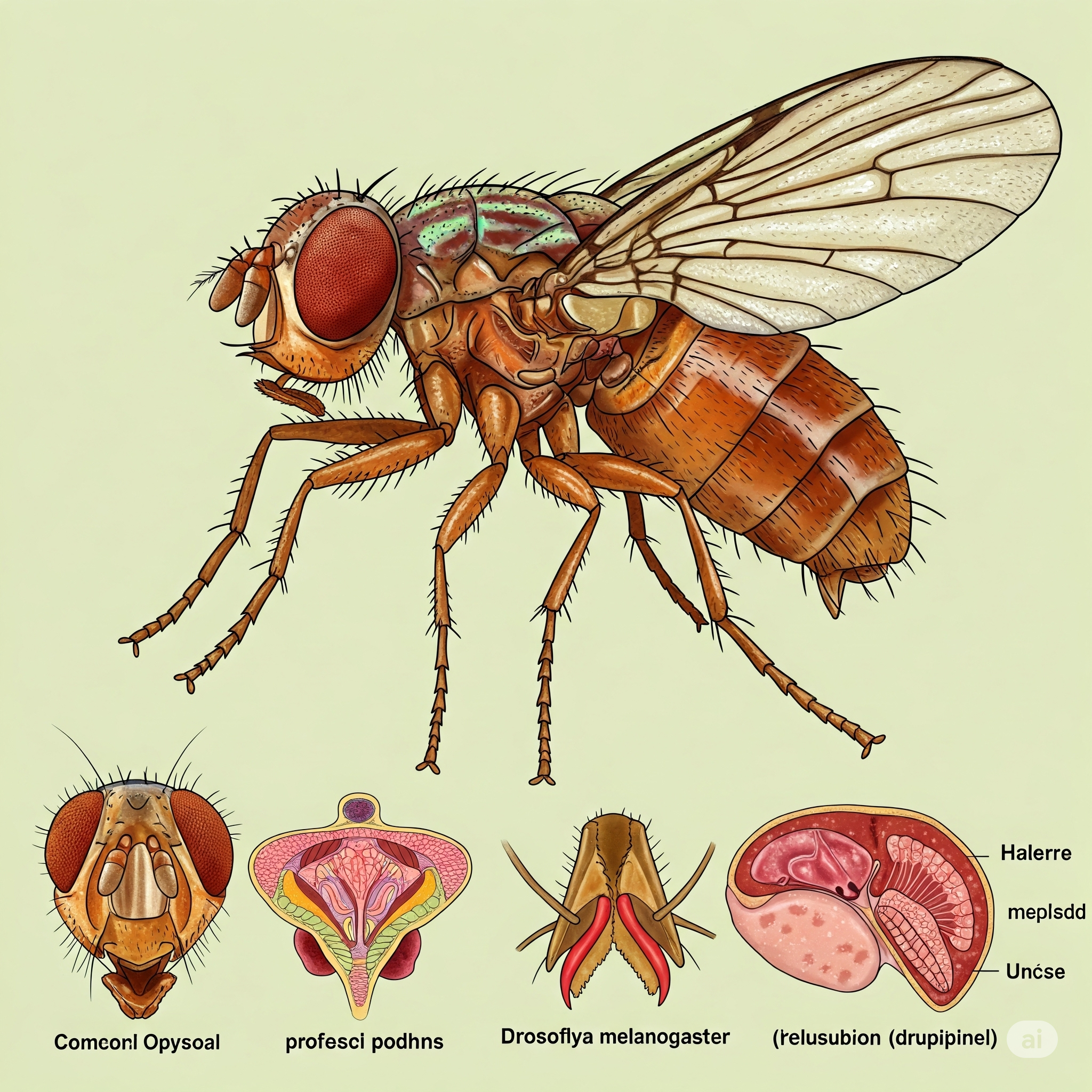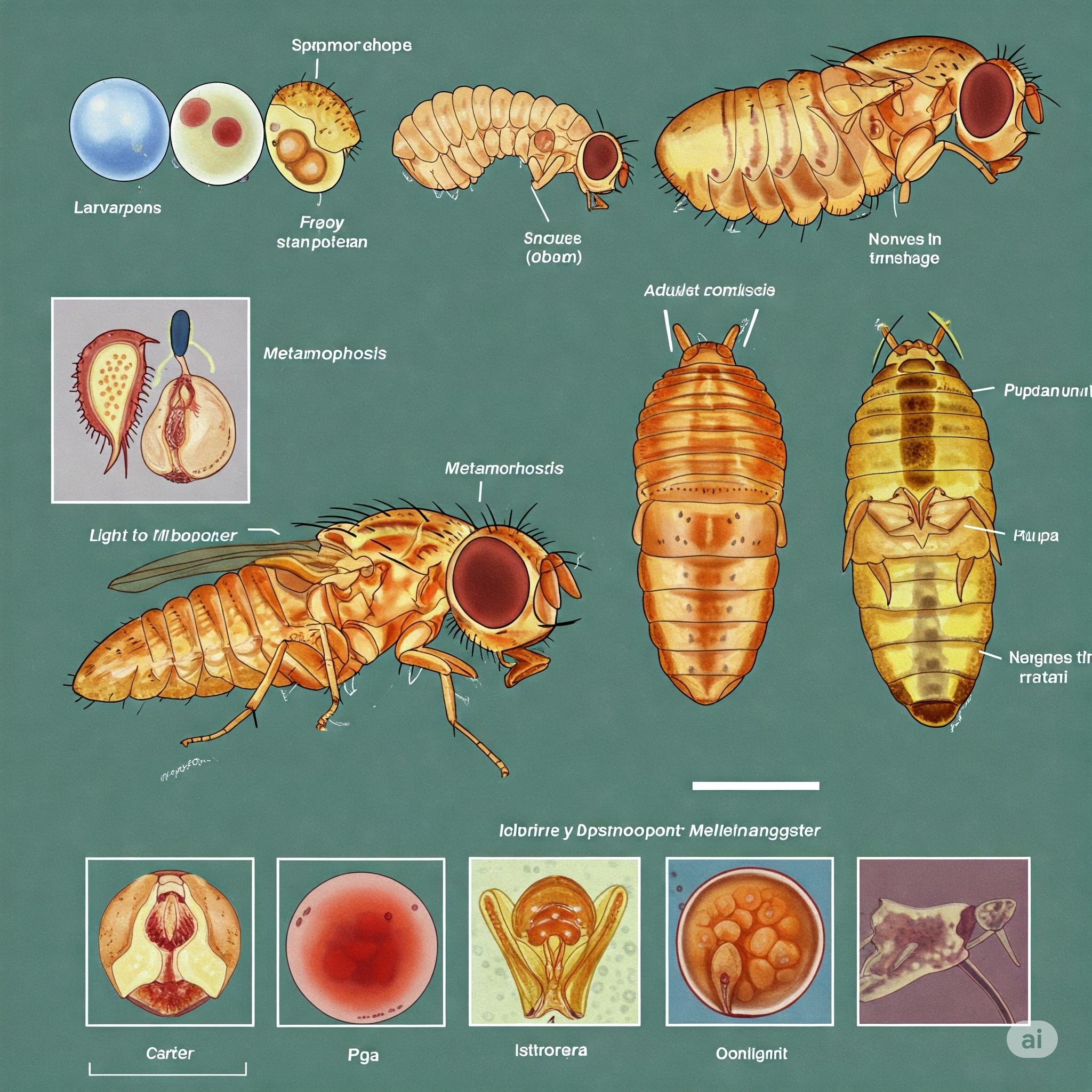The name “Fruit Fly” (Diptera: Drosophilidae) refers to small dipteran insects, mainly encompassing species of the genus Drosophila, which hold a central position in biological and genetic literature. Morphologically, they are recognized by their distinctive reddish compound eyes, yellowish-brown bodies, and slender forms measuring 2–4 mm in length. Especially the species Drosophila melanogaster has become one of the popular model organisms in experimental biology due to its short generation time, ease of laboratory rearing, and high egg production. Fruit flies are important not only in basic biological research but also as potential pests in agricultural ecosystems, causing economic losses during the post-harvest period. The following sections objectively and encyclopedically examine the taxonomic position, biological features, and comprehensive scientific-economic importance of the fruit fly.
Taxonomy and Evolutionary Position
Systematic Placement
Fruit flies (family Drosophilidae) belong to the order Diptera and represent a cosmopolitan family. The family includes more than 75 genera, such as Drosophila, Scaptodrosophila, Sophophora, Zaprionus, and Chymomyza. The genus Drosophila is divided into two major subgenera: the paraphyletic Drosophila subgenus and the monophyletic Sophophora subgenus. The model species D. melanogaster is classified in the latter. Molecular phylogenetic studies indicate that the Drosophilidae family diverged from other Cyclorrhapha lineages approximately 50–65 million years ago, with speciation events paralleling the geological processes of Gondwana’s breakup.
Diversity and Global Distribution
Currently, over 4,000 drosophilid species have been described, with a significant portion restricted to tropical latitudes. The highest species richness has been reported in humid biomes such as the Amazon basin, Southeast Asian rainforests, and the Great Rift Valley. Although species diversity decreases in temperate zones, cosmopolitan species such as Drosophila melanogaster (common fruit fly), Drosophila simulans (similar fruit fly), Drosophila suzukii (spotted wing drosophila), and Scaptodrosophila latifasciaeformis are widespread. In the last decade, invasive populations of vinegar flies like Drosophila suzukii have caused significant damage in the soft fruit sectors of Europe and North America, raising economic concerns.
Evolutionary Adaptations
Fruit flies exhibit a broad repertoire of ecological adaptations. For example, metapopulations of Drosophila mojavensis (Mojave fruit fly), which inhabit xeric environments, are characterized by an enhanced water reabsorption capacity in their kidney-like Malpighian tubules. Conversely, populations of Drosophila montana (mountain fruit fly), native to subarctic regions, have developed freeze tolerance by increasing the gene copy number coding for antifreeze proteins. A common evolutionary feature is the rapid response to selective pressures due to their short generation times. This adaptive dynamism is one of the main reasons fruit flies are preferred as model organisms in evolutionary biology.

Body Components (Created by Artificial Intelligence)
Biological Characteristics and Life Cycle
Morphology
The adult fruit fly’s body is divided into three main parts: head, thorax, and abdomen. The head features prominent compound eyes, three simple eyes (ocelli), and segmented antennae. The third segment of the antenna bears the arista, which contains radial sensilla and plays a role in detecting air currents and pheromone signals. The thoracic segments carry a pair of membranous wings and reduced halteres; these structures contribute to flight stabilization. The abdomen consists of five visible segments in males and seven in females. Sexual dimorphism is easily distinguishable by the presence of dark pigment bands and sex combs on males.
Reproduction and Embryogenesis
Female Drosophila melanogaster can lay an average of 50–80 eggs per day. Approximately 24 hours after oviposition, synchronized embryogenesis, characterized by rapid mitotic division, is completed, leading to the first larval stage. Segmentation genes (gap, pair-rule, segment polarity) and homeotic gene clusters (Hox) play key roles in establishing the spatial body plan during this process. Transcriptomic mapping of embryonic development has revealed that the maternal-to-zygotic gene transition begins at around 2 hours, with metabolic genes being activated at an early stage.

Reproduction and Embryogenesis (Created by Artificial Intelligence)
Larval Development and Metamorphosis
The larval stage consists of three instars and lasts approximately 96 hours under temperate conditions. Larvae are saprophagous, feeding on yeast cells and bacterial biofilms present in the decaying fruit matrix. This feeding behavior triggers the establishment of a symbiotic gut microbiota, which facilitates the synthesis of short-chain fatty acids that regulate the host’s lipid metabolism. After the third instar, the larva attaches itself to a substrate to form the puparium. The pupal stage is characterized by the proliferation of imaginal discs and organogenesis. At the end of this process, the adult individual with mature morphology emerges.

Larval Development and Metamorphosis (Created by Artificial Intelligence)
Behavior and Sensory Physiology
Despite their advanced chemosensory and visual systems, fruit flies provide a relatively simple model in neuroethology literature regarding behavioral repertoires. Male pheromones that attract females include polyketide-based compounds, primarily cuticular hydrocarbons. The well-known courtship sequence culminates with specific acoustic signals produced by wing vibrations. In orientation behavior, hunger state, environmental CO₂ concentration, and color contrasts are integrated simultaneously into decision-making mechanisms. The olfactory coding by the two antennal lobe glomeruli exhibits organizational principles parallel to the mammalian olfactory bulb.
Model Organism in Genetics and Developmental Biology
Thomas Hunt Morgan’s experiments with Drosophila melanogaster in the 1910s confirmed the chromosome theory, laying the foundation of modern genetics. Today, the D. melanogaster genome, containing approximately 14,000 protein-coding genes, has been fully sequenced and largely functionally annotated. Advanced techniques such as RNA interference (RNAi), CRISPR-Cas9-based gene editing, and somatic clone analysis have greatly accelerated the elucidation of gene-phenotype relationships. Compared to other animal models, low maintenance costs and minimal ethical restrictions ensure that the fruit fly remains a primary choice in genomics, neuroscience, and evolutionary biology research.


